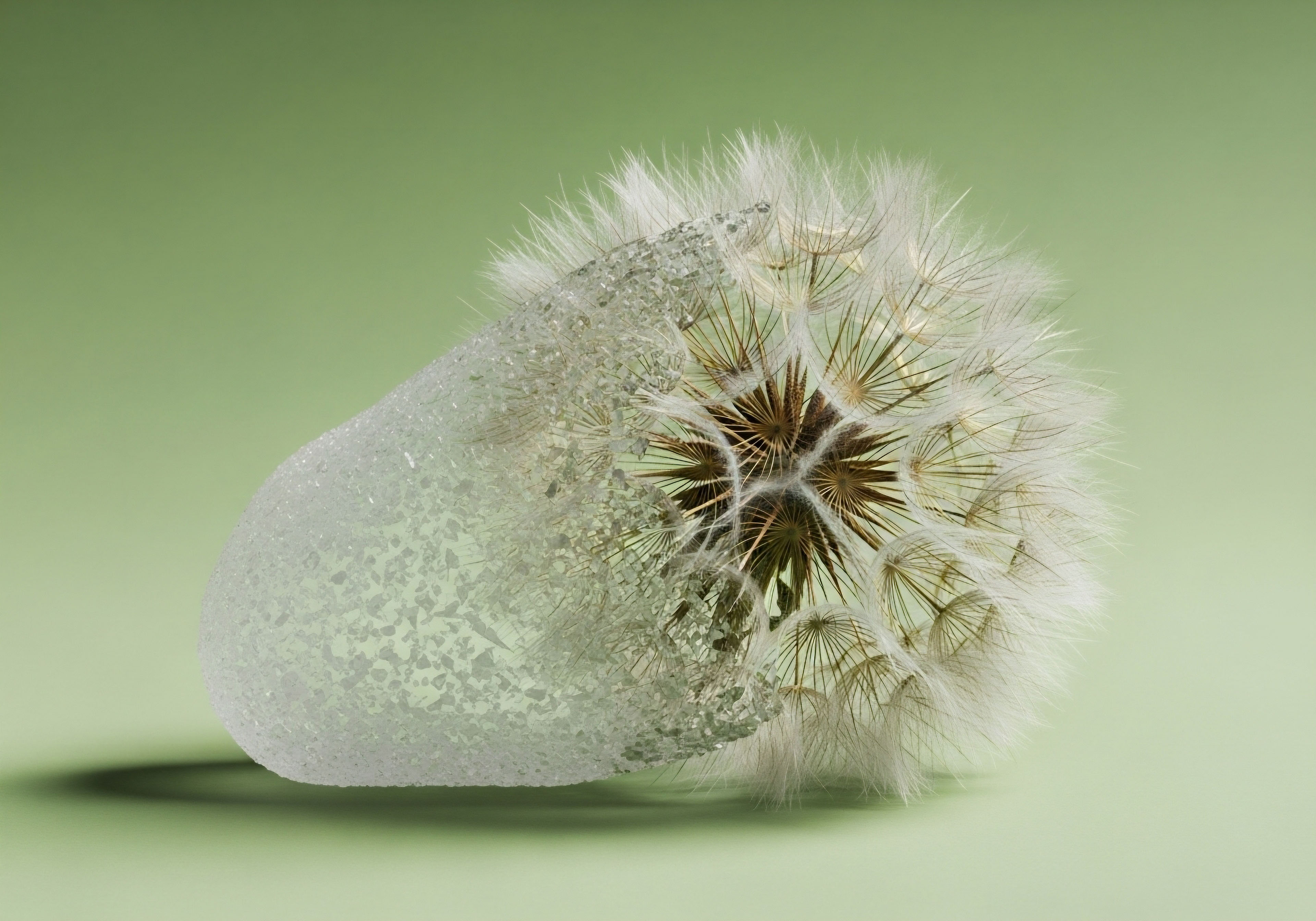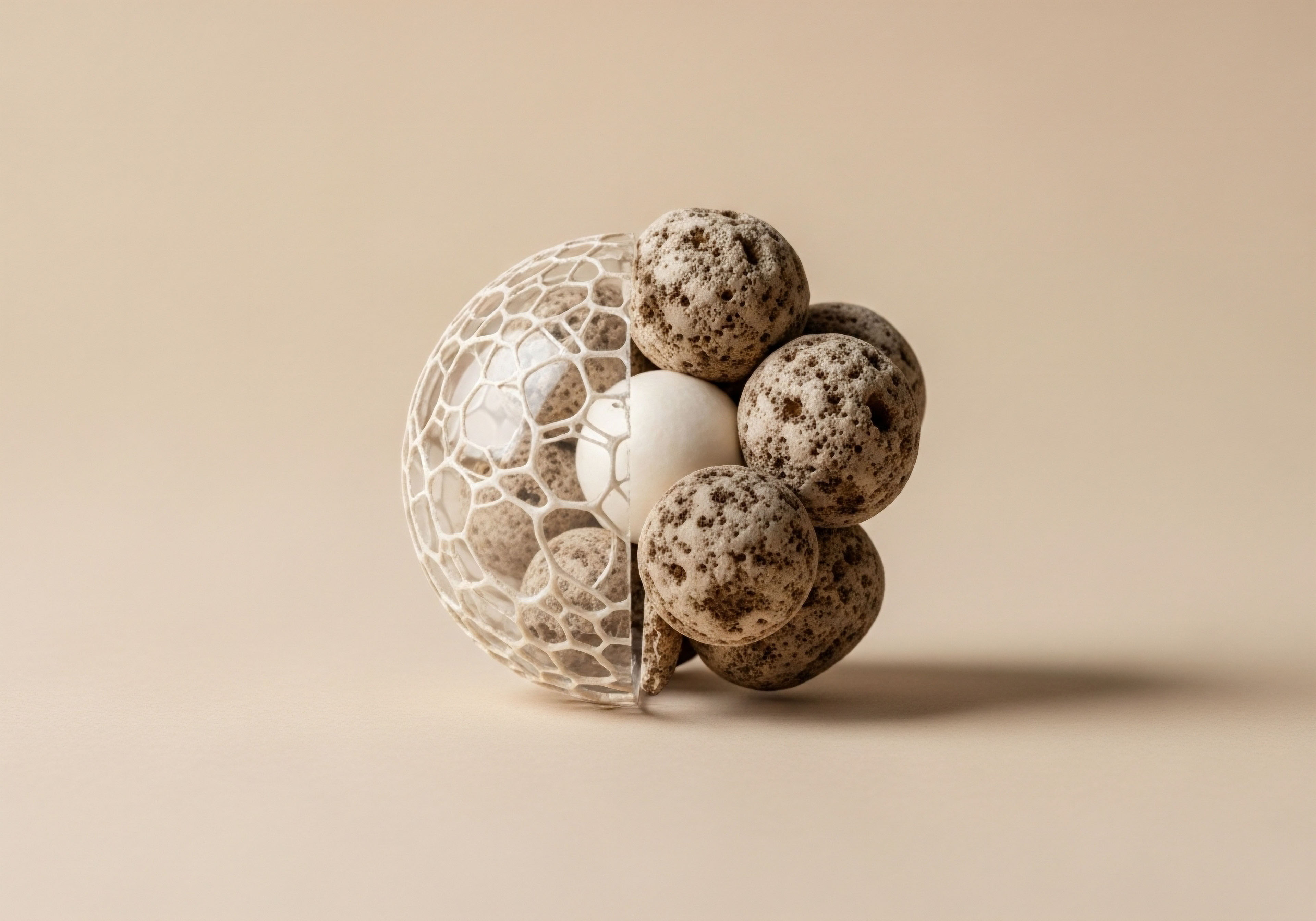

Fundamentals
The reflection in the mirror can sometimes present a disconnect from one’s internal sense of self. A perceived loss of skin vitality, a change in facial structure, or a shift in body composition are often interpreted as simple markers of time.
These changes are biological realities, direct readouts of the status of your body’s internal communication network ∞ the endocrine system. The texture of your skin, its ability to retain moisture, and its structural integrity are all governed by precise hormonal signals. When these signals diminish, the physical structures they support begin to change. This process is a physiological event, not a personal failing. Understanding this connection is the first step toward addressing the root causes of these visible and tangible shifts.
The human body is a complex biological system, and its appearance is a direct reflection of its internal health. Hormonal optimization protocols are designed to address the underlying biochemical changes that manifest as the signs of aging. By recalibrating the body’s hormonal signals, we can influence the very cellular processes that govern skin health, body composition, and overall vitality. This approach views aging through a physiological lens, seeking to restore the body’s systems to a state of optimal function.

The Cellular Architecture of Youthful Skin
Skin is a dynamic organ, its appearance and health intrinsically linked to a complex interplay of cellular activity and structural proteins. The dermis, the skin’s middle layer, houses the key components responsible for a youthful appearance. This is where fibroblasts, specialized cells, work tirelessly to produce collagen, elastin, and hyaluronic acid.
- Collagen ∞ This is the most abundant protein in the body, providing the skin with its fundamental structure and firmness. Think of it as the scaffolding that holds everything together. Healthy collagen levels result in plump, resilient skin.
- Elastin ∞ A protein that, as its name suggests, provides elasticity. It allows the skin to stretch and snap back into place. The degradation of elastin fibers leads to sagging and the formation of fine lines.
- Hyaluronic Acid ∞ This molecule is a humectant, meaning it attracts and retains water. Its presence in the dermis is what gives the skin its hydrated, dewy appearance. A single molecule can hold up to 1,000 times its weight in water.
The production of these three components is not constant throughout life. It is heavily regulated by hormonal signals, primarily from estrogen, progesterone, and testosterone. When these hormone levels are optimal, fibroblasts are robustly stimulated, maintaining the skin’s structural integrity. As these hormone levels decline, so does the production of these vital proteins, leading to the visible signs of aging.

Estrogen the Master Regulator of Skin Health
Estrogen is a primary signaling molecule for skin health in both women and men, although its effects are most pronounced in women. Estrogen receptors are abundant in the skin, particularly in the fibroblasts of the dermis. When estrogen binds to these receptors, it triggers a cascade of events that directly stimulates the production of collagen and hyaluronic acid.
This is why, during periods of high estrogen, such as the reproductive years, the skin tends to be thicker, more hydrated, and more elastic. The decline in estrogen during perimenopause and menopause removes this critical stimulus. Collagen production can decrease by as much as 30% in the first five years of menopause, leading to a rapid acceleration in skin thinning, dryness, and wrinkle formation. Restoring estrogen to physiological levels can help maintain the skin’s thickness and moisture content.

The Supportive Roles of Progesterone and Testosterone
Progesterone also contributes to skin health, working in concert with estrogen. It has been shown to improve skin elasticity and firmness. Progesterone appears to support the structural integrity of the skin, and its decline can contribute to a loss of tone. In both men and women, testosterone plays a role in sebum production, the skin’s natural oil.
Healthy sebum levels provide a protective barrier, preventing moisture loss. While excessive testosterone can lead to acne, insufficient levels can result in dry, irritated skin. In men, testosterone is also a key driver of muscle mass and bone density, which contribute to facial structure and overall physique. The decline of these hormones is a systemic issue with visible consequences.
The visible changes associated with aging are a direct result of declining hormonal signals that regulate the cellular machinery of the skin and body.

Body Composition and the Hormonal Blueprint
The shape and composition of the human body are also dictated by hormonal signals. The distribution of fat and muscle is not random; it is a carefully orchestrated process governed by testosterone and estrogen, as well as growth hormone. During youth, higher levels of these hormones promote a lean, muscular physique.
Testosterone, in particular, is a powerful anabolic hormone, meaning it builds tissue. It increases protein synthesis, leading to muscle growth, and also plays a role in burning fat. Estrogen influences fat distribution, typically directing it to the hips and thighs in women.
As hormonal levels decline with age, this blueprint changes. In men, lower testosterone leads to a decrease in muscle mass and an increase in visceral fat, the metabolically active fat that accumulates around the organs. This shift not only alters physical appearance but also carries significant health implications.
In women, the loss of estrogen during menopause causes a shift in fat distribution from the hips and thighs to the abdomen, a pattern similar to that seen in men. This change in body composition is a hallmark of hormonal aging and can be addressed by restoring hormonal balance.
Hormone replacement therapy, therefore, is a medical intervention designed to address these fundamental biological processes. By replenishing the body’s declining hormonal signals, it is possible to support the cellular functions that maintain youthful skin and body composition. This is a systems-based approach to wellness, one that recognizes the profound connection between our internal biochemistry and our external appearance.


Intermediate
Understanding that hormonal decline is at the root of many age-related changes is the foundational step. The next is to comprehend the specific clinical protocols designed to counteract this process. These are not one-size-fits-all solutions but carefully calibrated interventions tailored to an individual’s unique biochemistry and health status.
The goal of these hormonal optimization protocols is to restore the body’s internal signaling to a more youthful and functional state. This involves the use of bioidentical hormones and targeted peptides to replicate the physiological environment of our younger years. These protocols are grounded in clinical science, with established procedures for administration, monitoring, and adjustment.

Protocols for Female Endocrine System Support
For women, hormonal recalibration typically focuses on addressing the symptoms of perimenopause and menopause, which are driven by the decline in estrogen, progesterone, and, to a lesser extent, testosterone. The aim is to alleviate symptoms like hot flashes, mood swings, and sleep disturbances, while also providing long-term benefits for bone density, cardiovascular health, and skin vitality. According to The Endocrine Society, menopausal hormone therapy is the most effective treatment for these symptoms.

Estrogen and Progesterone Replacement
The cornerstone of female hormone therapy is the replacement of estrogen, the hormone responsible for maintaining the health of numerous bodily tissues, including the skin. Estrogen can be administered in various forms, including transdermal patches, gels, or creams. These methods allow for a steady, controlled release of the hormone into the bloodstream, mimicking the body’s natural production.
For women who have a uterus, estrogen therapy must be balanced with progesterone. Progesterone’s role is to protect the uterine lining from the proliferative effects of estrogen. It can be prescribed as an oral capsule or a topical cream and also contributes to mood stability and sleep quality. This balanced approach ensures both safety and efficacy.

The Role of Low-Dose Testosterone for Women
A growing body of clinical evidence supports the use of low-dose testosterone therapy for women, particularly for addressing symptoms like low libido, fatigue, and a diminished sense of well-being. Testosterone also contributes to muscle mass and bone density in women.
A typical protocol involves weekly subcutaneous injections of a low dose of Testosterone Cypionate, usually between 10-20 units (0.1-0.2ml). This small amount is sufficient to restore testosterone to the upper end of the normal female range, enhancing energy levels and physical resilience without causing masculinizing side effects. The addition of testosterone to a female hormone replacement protocol can provide a significant improvement in quality of life and physical function.

Protocols for Male Endocrine System Support
For men, the primary focus of hormonal optimization is addressing andropause, or low testosterone (hypogonadism). The Endocrine Society provides clear clinical practice guidelines for the diagnosis and treatment of this condition. Symptoms include fatigue, depression, reduced muscle mass, and increased body fat.
Testosterone Replacement Therapy (TRT) is designed to restore testosterone to optimal levels, reversing these symptoms and improving overall health. A standard protocol involves weekly intramuscular injections of Testosterone Cypionate (200mg/ml). This is a long-acting form of testosterone that provides stable blood levels.
Clinical protocols for hormonal optimization are designed to restore physiological signaling, addressing the root biochemical causes of age-related changes.

Maintaining Systemic Balance during TRT
A comprehensive male TRT protocol includes more than just testosterone. To maintain the body’s natural hormonal balance and prevent side effects, two other medications are often included:
- Gonadorelin ∞ When the body receives external testosterone, it can reduce its own production, a process regulated by the Hypothalamic-Pituitary-Gonadal (HPG) axis. This can lead to testicular atrophy and reduced fertility. Gonadorelin is a peptide that mimics Gonadotropin-Releasing Hormone (GnRH), signaling the pituitary gland to continue producing Luteinizing Hormone (LH) and Follicle-Stimulating Hormone (FSH). This maintains natural testosterone production and testicular function. It is typically administered twice a week via subcutaneous injection.
- Anastrozole ∞ Testosterone can be converted into estrogen in the body through a process called aromatization. In men, excessive estrogen can lead to side effects like water retention and gynecomastia (breast tissue development). Anastrozole is an aromatase inhibitor, a medication that blocks this conversion. It is taken as a small oral tablet, usually twice a week, to keep estrogen levels in a healthy range.
This three-part approach to TRT ensures that testosterone levels are optimized while the body’s endocrine system remains in balance. Regular blood work is used to monitor hormone levels and adjust dosages as needed, ensuring a personalized and effective treatment plan.

Growth Hormone Peptide Therapy for Systemic Rejuvenation
Beyond sex hormones, another critical component of the body’s age-related decline is the reduction in Growth Hormone (GH) production. GH is essential for cellular repair, metabolism, and tissue regeneration. Directly replacing GH can be costly and has potential side effects. A more sophisticated approach is to use peptide therapies that stimulate the body’s own pituitary gland to produce more GH naturally. These peptides are known as growth hormone secretagogues.
A widely used and effective combination is Ipamorelin and CJC-1295. These two peptides work synergistically to create a powerful and sustained release of GH. Ipamorelin provides a strong, clean pulse of GH release, while CJC-1295 extends the duration of that release. This combination is administered via subcutaneous injection, typically before bed to mimic the body’s natural GH release cycle. The benefits of this therapy include:
- Improved Skin Quality ∞ Increased GH levels stimulate collagen production, leading to thicker, more elastic skin and a reduction in wrinkles.
- Enhanced Body Composition ∞ GH is a potent lipolytic agent, meaning it helps the body burn fat. It also promotes lean muscle growth.
- Better Sleep and Recovery ∞ GH plays a key role in deep sleep and cellular repair, leading to improved recovery from exercise and a greater sense of well-being.
The following table outlines the key differences between these primary hormonal optimization protocols:
| Protocol | Primary Hormones/Peptides | Target Audience | Primary Aesthetic Benefits |
|---|---|---|---|
| Female HRT | Estrogen, Progesterone, Low-Dose Testosterone | Peri/Post-Menopausal Women | Improved skin elasticity, hydration, and thickness; reduced wrinkles; stable body composition. |
| Male TRT | Testosterone Cypionate, Gonadorelin, Anastrozole | Men with low testosterone | Increased muscle mass, decreased body fat, improved facial structure, healthier skin. |
| GH Peptide Therapy | Ipamorelin, CJC-1295 | Adults seeking systemic anti-aging | Enhanced collagen production, reduced wrinkles, fat loss, lean muscle preservation. |
These intermediate protocols represent a targeted, evidence-based approach to managing the aging process. By working with the body’s own biological systems, they offer a way to restore function and vitality from the inside out.


Academic
A sophisticated analysis of hormonal optimization therapies requires a deep examination of the molecular and cellular mechanisms through which these interventions exert their effects. The aesthetic benefits observed with hormone replacement are the macroscopic outcomes of microscopic events ∞ the binding of hormones to specific nuclear receptors, the subsequent modulation of gene transcription, and the resulting alterations in protein synthesis.
This section will dissect the intricate interplay between sex hormones, growth hormone secretagogues, and the cellular machinery of the skin and musculoskeletal system, grounding the discussion in established endocrinological and physiological principles.

What Is the Cellular Mechanism of Estrogen on Dermal Fibroblasts?
The profound effect of estrogen on skin health is mediated primarily through its interaction with two specific nuclear receptors ∞ Estrogen Receptor Alpha (ERα) and Estrogen Receptor Beta (ERβ). Both receptor subtypes are expressed in dermal fibroblasts, keratinocytes, and other skin cells. Upon entering the cell, 17β-estradiol, the most potent form of estrogen, binds to these receptors.
This hormone-receptor complex then translocates to the nucleus, where it functions as a ligand-activated transcription factor. It binds to specific DNA sequences known as Estrogen Response Elements (EREs) in the promoter regions of target genes.
Research has demonstrated that this binding event directly upregulates the transcription of genes encoding for type I and type III collagen. This increase in messenger RNA (mRNA) for collagen leads to a corresponding increase in protein synthesis by the fibroblasts, resulting in a thicker, more structurally sound dermal matrix.
Furthermore, estrogen has been shown to increase the expression of genes for hyaluronic acid synthase, the enzyme responsible for producing hyaluronic acid. This enhances the skin’s ability to retain water, contributing to improved turgor and hydration. Concurrently, estrogen downregulates the expression of matrix metalloproteinases (MMPs), a family of enzymes responsible for the degradation of collagen and elastin. This dual action of stimulating production while inhibiting degradation is what makes estrogen such a powerful agent for maintaining skin integrity.

How Does Testosterone Regulate Myogenesis and Adipogenesis?
Testosterone’s influence on body composition is a result of its powerful effects on muscle and fat cells. In skeletal muscle, testosterone binds to androgen receptors (AR) on satellite cells, the progenitor cells responsible for muscle repair and growth. This binding stimulates the proliferation and differentiation of these satellite cells, leading to muscle fiber hypertrophy.
Testosterone also directly increases the rate of protein synthesis within existing muscle fibers. Studies using dual-energy x-ray absorptiometry (DEXA) have consistently shown that TRT produces a significant increase in lean body mass and a corresponding decrease in fat mass, often without a change in overall body weight. One study documented a 4.5% increase in lean mass and a 9.1% decrease in fat mass over 24 months of treatment.
Simultaneously, testosterone influences adipogenesis, the formation of fat cells. It appears to inhibit the differentiation of pre-adipocytes into mature fat cells, particularly in the visceral abdominal region. This contributes to the reduction in waist circumference and visceral fat stores seen with TRT.
The decrease in fat mass is also linked to testosterone’s role in improving insulin sensitivity, which enhances the body’s ability to manage glucose and partition nutrients towards muscle tissue instead of fat storage. The result is a fundamental shift in the body’s metabolic environment, favoring anabolism in muscle and catabolism in adipose tissue.
The aesthetic outcomes of hormonal therapies are the direct result of targeted molecular actions on gene expression and protein synthesis within specific cell types.

The Synergistic Action of Ipamorelin and CJC-1295 on the Pituitary
Growth hormone peptide therapy with Ipamorelin and CJC-1295 represents a sophisticated manipulation of the somatotropic axis. These two peptides work on different receptors within the pituitary gland to stimulate the release of Growth Hormone (GH). CJC-1295 is a synthetic analogue of Growth Hormone-Releasing Hormone (GHRH).
It binds to the GHRH receptor on somatotroph cells in the anterior pituitary, stimulating the synthesis and release of GH. Its chemical structure is modified to resist degradation by the enzyme dipeptidyl peptidase-4 (DPP-4), giving it a much longer half-life than endogenous GHRH and allowing for a sustained elevation of GH levels.
Ipamorelin, on the other hand, is a ghrelin mimetic. It binds to the Growth Hormone Secretagogue Receptor (GHSR) on somatotrophs. This is a separate pathway from the GHRH receptor. The activation of the GHSR also triggers a powerful release of GH.
Ipamorelin is highly specific for the GHSR, meaning it does not significantly increase levels of other hormones like cortisol or prolactin, which can be a side effect of older secretagogues. By combining CJC-1295 and Ipamorelin, both the GHRH and GHSR pathways are stimulated simultaneously.
This creates a synergistic effect, resulting in a larger and more prolonged release of GH than either peptide could achieve alone. This amplified, yet still physiological, pulse of GH is what drives the downstream benefits of increased IGF-1 production, enhanced collagen synthesis, and improved lipolysis.
The following table presents a summary of the cellular mechanisms discussed:
| Hormone/Peptide | Target Cell | Receptor | Primary Molecular Action | Resulting Physiological Effect |
|---|---|---|---|---|
| Estrogen (17β-estradiol) | Dermal Fibroblast | ERα, ERβ | Upregulates collagen and hyaluronic acid gene transcription; downregulates MMPs. | Increased skin thickness, hydration, and elasticity. |
| Testosterone | Muscle Satellite Cell | AR | Stimulates proliferation and differentiation; increases protein synthesis. | Increased lean muscle mass. |
| Ipamorelin/CJC-1295 | Pituitary Somatotroph | GHSR / GHRH-R | Synergistically stimulates the synthesis and release of Growth Hormone. | Increased systemic GH and IGF-1 levels, leading to global tissue repair and improved metabolism. |
In conclusion, the practice of using hormonal therapies for aesthetic and anti-aging purposes is firmly rooted in a deep understanding of cellular and molecular biology. These interventions are designed to precisely target the hormonal signaling pathways that degrade with age, restoring the genetic and protein expression patterns that define a more youthful physiology. The visible improvements in skin quality and body composition are the external validation of this internal biochemical recalibration.

References
- Bhasin, S. et al. “Testosterone Therapy in Men with Hypogonadism ∞ An Endocrine Society Clinical Practice Guideline.” The Journal of Clinical Endocrinology & Metabolism, vol. 103, no. 5, 2018, pp. 1715-1744.
- Stuenkel, C. A. et al. “Treatment of Symptoms of the Menopause ∞ An Endocrine Society Clinical Practice Guideline.” The Journal of Clinical Endocrinology & Metabolism, vol. 100, no. 11, 2015, pp. 3975-4011.
- Lephart, Edwin D. “Updated Perspectives on the Role of Estrogens in Skin Aging.” Clinical, Cosmetic and Investigational Dermatology, vol. 15, 2022, pp. 1629-1647.
- Holzer, G. et al. “Effects of topical progesterone on skin elasticity and skin thickness in peri- and postmenopausal women.” International Journal of Dermatology, vol. 44, no. 3, 2005, pp. 199-204.
- Sattler, F. R. et al. “Testosterone and growth hormone improve body composition and muscle performance in older men.” Journal of Clinical Endocrinology & Metabolism, vol. 94, no. 6, 2009, pp. 1991-2001.
- Sinha, D. K. et al. “Beyond the natural anabolics ∞ the role of growth hormone and its secretagogues.” Translational Andrology and Urology, vol. 9, suppl. 2, 2020, pp. S159-S171.
- Ganceviciene, R. et al. “Skin anti-aging strategies.” Dermato-Endocrinology, vol. 4, no. 3, 2012, pp. 308-319.
- Shahidi, B. et al. “Testosterone treatment in males with testosterone deficiency syndrome ∞ effects on body composition and clinical symptoms.” Journal of Sexual Medicine, vol. 8, no. 1, 2011, pp. 244-255.

Reflection
The information presented here provides a map of the biological territory, connecting symptoms to systems and interventions to mechanisms. It is a framework for understanding the physiological shifts that occur over time. This knowledge is a starting point. Your own biological system is unique, with its own history and its own specific requirements.
The path toward sustained vitality is one of personalized analysis and precise calibration. Consider where your own experiences align with these biological principles. Reflect on the concept that your body’s appearance is a form of data, a constant stream of information about your internal health. The potential to influence these systems begins with a deep and objective understanding of their function.



